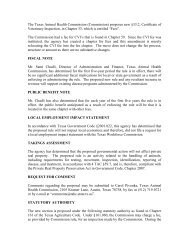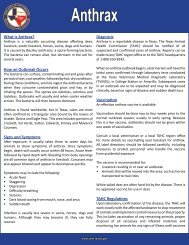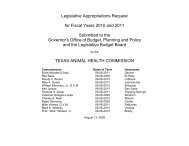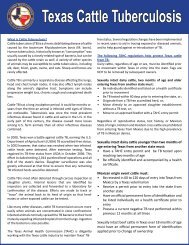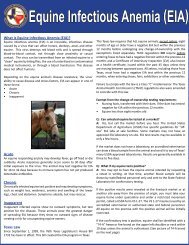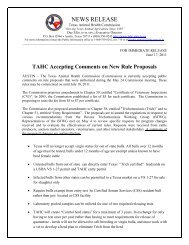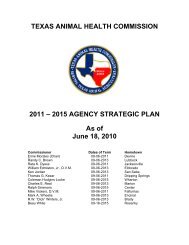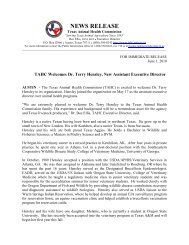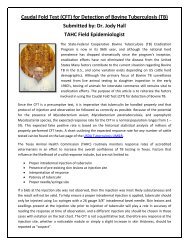TAHC Piroplasmosis Brochure - Texas Animal Health Commission
TAHC Piroplasmosis Brochure - Texas Animal Health Commission
TAHC Piroplasmosis Brochure - Texas Animal Health Commission
Create successful ePaper yourself
Turn your PDF publications into a flip-book with our unique Google optimized e-Paper software.
veterinary technician under direct supervision.Official Test ChartA completed EP Laboratory Test Chart (<strong>TAHC</strong> Form 10-07)must be submitted with the blood sample, which shouldinclude all official identification on the horse. Eithera manual illustration of distinctive markings or digitalphotos clearly showing the animals full face, right, andleft side must also be used with the chart.In the absence of any distinctive marking, colors or visiblepermanent identification (brands, tattoos, or scars), theanimal must be identified with an “X” on the illustrationprovided on the chart indicating the location of any hairwhorls, vortices or cowlicks.unique tattoo. Tick control management techniques arealso required for the stall or pasture where an infectedhorse resides.Treatment of Infected EquineWorking with their private veterinarian, a horse ownermay also choose to have their horse treated for EP attheir own expense. After the treatment period, follow-uptests must be conducted which may satisfy conditions fora quarantine release. Although, there are no guarantees.Field studies have demonstrated success in clearing somehorses affected with EP. The Agreement for Treatment andother information may be obtained by contacting your<strong>TAHC</strong> Region office, <strong>TAHC</strong> Austin office or <strong>TAHC</strong> websiteat http://www.tahc.texas.gov/agency/contact.html.Management of Infected EquineEP infected horses should be removed from contact withother horses and then kept in permanent quarantine under<strong>TAHC</strong> specified conditions. Quarantined horses must bebranded with the letter “P”, identified with a microchipor have other acceptable forms of identification such as aInformation provided by the<strong>Texas</strong> <strong>Animal</strong> <strong>Health</strong> <strong>Commission</strong> (<strong>TAHC</strong>)P.O. Box 12966-2966Austin, TX 78711Phone: 1-800-550-8242Website: www.tahc.texas.govFacebook: www.facebook.com/<strong>Texas</strong>AHCTwitter: www.twitter.com/<strong>TAHC</strong><strong>Texas</strong> Racetrack RequirementsBy <strong>TAHC</strong> rule, equine entering a <strong>Texas</strong> racetrack facilitymust have a negative EP (T. equi only) test within the past12 months.Horses Imported into <strong>Texas</strong> from Foreign CountriesA test for EP (as well as Equine Infectious Anemia,Glanders and Dourine) is routinely conducted by USDAveterinarians at the port of entry prior to final entry intothe U.S. A test is not required on horses entering <strong>Texas</strong>form other states. Horse owners should check in advancefor the entry requirements of the state of destination ifthey are planning to move a <strong>Texas</strong> horse to another state.For more information on Equine <strong>Piroplasmosis</strong>, contactthe <strong>TAHC</strong> headquarters at 1-800-8242, your regional<strong>TAHC</strong> office, or visit the <strong>TAHC</strong> website at www.tahc.texas.gov.TEXAS ANIMAL HEALTH COMMISSION• •Since1893SERVING TEXAS ANIMAL AGRICULTURENovember 2014



